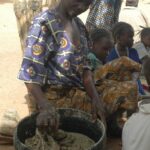Goats are prolific across the Sahel. Livestock is the most common form of investment here and goats survive well in the harsh, arid environment. While the staple food in the North is millet, mutton and goat meat is traditionally eaten at festivals and other celebrations. Nothing is wasted. Goat skin is perfect for fine craftwork such as braiding horse harnesses. These straps are a feature of all SAHEL fashion accessories – bags, belts, dog leads and keyrings. Whenever we need coloured straps, we buy goatskin that has been dyed in the UK to ensure the colour is fast and that effluents are disposed of in an environmentally friendly way. All our natural tan leather straps and tassles are made by the traditional method described here.
First the wood of a kojoli tree is burned to make ash (ndoondi) which is mixed with water. The goat skin is soaked in this for 3 days (see Image 1), after which the hairs can easily be scraped off with a knife (Image 2). Then the skin is soaked for a day or more in a mix of water and gawde, which are pods from a nearby acacia tree (Image 3). These young pods contain tannin. (they are also edible and can be used to make red and yellow dyes).
When the skin is soft, it is rinsed in water, wrung out, and then bashed vigorously across the side of a pounding pot for about 20 minutes to make it even softer (Image 4). It is then scraped again on the underside and left in the sun to dry (Image 5). The whole process is natural and uses no chemicals.
The downside is that the leather can be quite smelly and a product made using a large amount of naturally tanned leather will need a good airing to loose its pungency. Most SAHEL bags employ this leather only for the braided handles so this is not a problem.







Is this the process used to cure a goat skin for a djembe drum?
I believe it is the same. Instead of hanging it up to dry, the skin would be stretched over the drum and left to dry and tighten.
I would like to start a business in goat skin curing in Vryheid, Kwazulu Natal. This would entail a project that will serve the community and help with poverty alleviation. In order for me to submit a proposal to the local municipality, I would like you to furnish me with the required information.
Hi ,I would like to start making leather from goat skin. Kindly teach me how to do it, we have a lot goat skin going to waste in my area.
Hi Walter, I’m sorry I am not able to give you more detail than what you can see in this blogpost. I am not the artisan myself, I am reporting on the work of these artisans and am no longer in close contact with them. It is a family business and their skill has taken years to perfect. I hope you find someone who can teach you, so that the goat skins are not wasted.